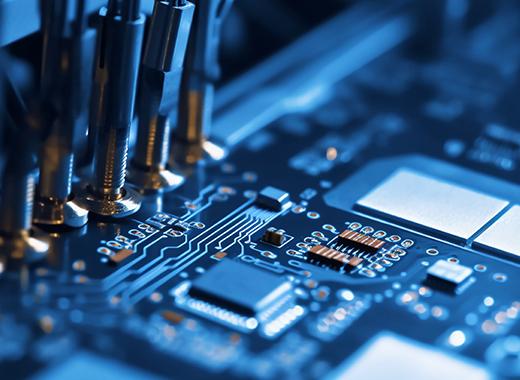This mold temperature controller offers precise temperature control (±0.1℃), ensuring stable product quality for injection molding processes. It features easy operation with a digital display for real-time monitoring.




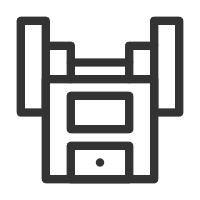

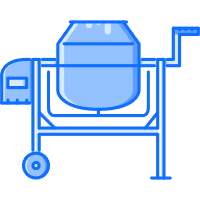
This mold temperature controller offers precise temperature control (±0.1℃), ensuring stable product quality for injection molding processes. It features easy operation with a digital display for real-time monitoring.
The 15HP air-cooled shell-and-tube chiller is an industrial-grade solution for high-load refrigeration, with a cooling capacity of 44.46LW. Its core is a high-efficiency shell-and-tube heat exchanger; with full tube-shell heat exchange, its efficiency is 15%-20% higher than ordinary exchangers, quickly meeting continuous cooling needs of large industrial workshops, commercial complex central air conditioners and high-load production lines. It features an enhanced air-cooled module with a large-diameter fan and optimized air duct, maintaining stable heat dissipation in high temperatures without a water-cooling system, greatly reducing site infrastructure costs. The shell-and-tube exchanger has strong pressure resistance and anti-scaling ability; paired with a built-in high-precision filter, it intercepts circulating water impurities, reducing blockage risks and extending equipment maintenance cycles.

The 5-HP air-cooled chiller -15℃ is a high-performance ultra-low temperature refrigeration equipment with 12500W cooling capacity. It stably outputs -15℃, suitable for medium/large low-temperature scenarios like frozen food processing, biomedical storage and industrial low-temperature assembly. Equipped with an enhanced air-cooled system, it maintains efficient heat dissipation under low-temperature conditions, no external water-cooling needed, and offers flexible installation for various sites. It has multiple safety protections (low-temperature overload, compressor overpressure) to avoid damage in extreme conditions. The built-in high-efficiency detachable filter intercepts impurities, preventing pipeline blockage and component freezing to extend service life. The intelligent temperature control system keeps fluctuation within ±0.5℃, balancing low-temperature accuracy and energy economy, making it an efficient and reliable refrigeration choice for low-temperature fields.
Targeting the cooling needs of commercial buildings, this energy-saving water-cooled screw chiller system is an ideal choice. It adopts intelligent frequency conversion control technology, which can automatically adjust the operating power according to changes in indoor and outdoor temperatures. While ensuring comfortable temperature and humidity in commercial spaces such as shopping malls and office buildings, it significantly reduces operating energy consumption. The compact modular design also facilitates flexible installation and layout in building machine rooms.
This high-efficiency water-cooled screw chiller is specifically designed for large-scale industrial cooling needs. Leveraging advanced screw compression technology, it can stably deliver strong refrigeration capacity under high-load conditions. Its optimized heat exchange system significantly improves heat transfer efficiency, effectively reducing energy consumption per unit of refrigeration. It provides continuous and stable low-temperature environment support for large-scale industrial production processes such as steel and chemical industries, helping enterprises achieve efficient production.
The water - cooled screw chiller is a high - performance refrigeration equipment designed to meet diverse industrial and commercial cooling needs. With advanced technology and reliable components, it ensures stable and efficient cooling operation.
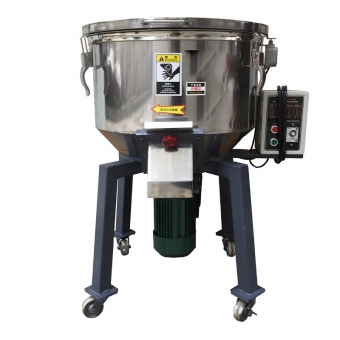
The vertical mixer machine is a space-saving industrial blending solution for diverse materials. Its high-torque motor and adjustable speed settings handle granular, powdery, or viscous pastes, ensuring uniform mixing. The sealed chamber prevents contamination and dust leakage, suitable for food, plastic processing, chemical, and building materials industries. Durable stainless steel construction ensures longevity, while user-friendly design simplifies operation, discharge, and maintenance. Ideal for small to medium production lines, it enhances product quality and efficiency across applications.
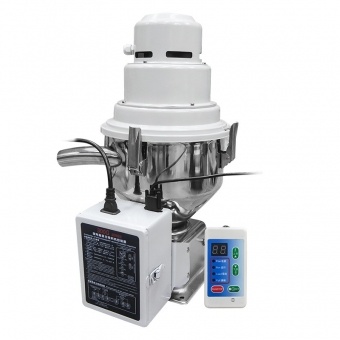
The vacuum hopper loader is an efficient automatic material conveying device, using vacuum suction technology to achieve dust-free transfer of granular, powdery or pellet materials. Equipped with intelligent control and material level sensors, it enables automatic start-stop and steady feeding, reducing manual labor. With hygienic closed-loop design, stainless steel or wear-resistant components, it ensures safe and durable operation. Suitable for plastic processing, food, pharmaceutical and chemical industries, it integrates easily into production lines for cost-effective and high-quality conveying.
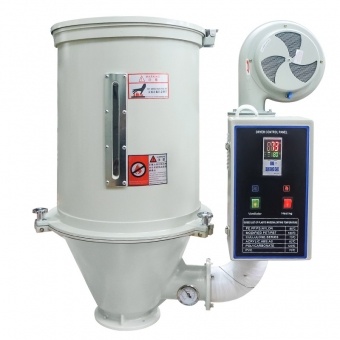
Industrial hopper dryers provide professional plastic material drying solutions with efficient heating systems and fans for uniform moisture removal, ensuring raw materials meet production standards; their safety-focused design includes reliable over-temperature protection to prevent operational risks, while compact structures with stable bases enable secure placement, manageable package sizes and weights simplify transport and installation, making them ideal for drying plastic pellets and granules in injection molding, extrusion, and other plastic processing scenarios, with industrial-grade performance on standard power to support stable production and high-quality end products.
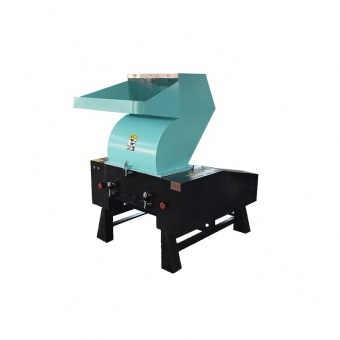
A plastic crusher machine is a device used to crush plastic into small pieces for easy disposal. The machine works by breaking down the plastic material into small pieces using a rotating blade. The crushed plastic can then be melted down and reused to make new products, thus reducing the amount of plastic waste in the environment. It is an essential machine in the plastic recycling process.
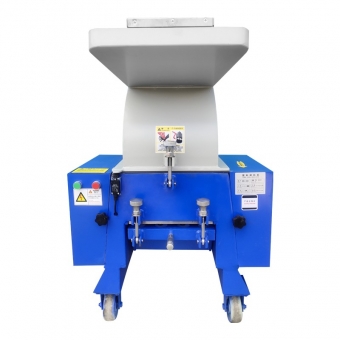
Plastic crushers specialize in breaking various plastic materials into plastic particles of different sizes. Crushed plastic can be recycled for use in the reproduction of plastic products, which is an important raw material for plastic recycling and pelletizing. It has the advantages of small space occupation, low power consumption, simple operation, and easy cleaning and maintenance. The particle size can be adjusted by replacing the screen.
Plastic crusher, also known as plastic grinder, is mainly used to crush various plastic and rubber materials, such as plastic profiles, pipes, rods, filaments, films and waste rubber products. It is widely used in waste - plastic recycling and the recycling of factory waste. The motor power of the plastic crusher is between 3.5 and 150 kilowatts, and the knife - roller speed is generally between 150 and 500 rpm.
The 15HP air-cooled shell-and-tube chiller is an industrial-grade solution for high-load refrigeration, with a cooling capacity of 44.46LW. Its core is a high-efficiency shell-and-tube heat exchanger; with full tube-shell heat exchange, its efficiency is 15%-20% higher than ordinary exchangers, quickly meeting continuous cooling needs of large industrial workshops, commercial complex central air conditioners and high-load production lines. It features an enhanced air-cooled module with a large-diameter fan and optimized air duct, maintaining stable heat dissipation in high temperatures without a water-cooling system, greatly reducing site infrastructure costs. The shell-and-tube exchanger has strong pressure resistance and anti-scaling ability; paired with a built-in high-precision filter, it intercepts circulating water impurities, reducing blockage risks and extending equipment maintenance cycles.

The 5-HP air-cooled chiller -15℃ is a high-performance ultra-low temperature refrigeration equipment with 12500W cooling capacity. It stably outputs -15℃, suitable for medium/large low-temperature scenarios like frozen food processing, biomedical storage and industrial low-temperature assembly. Equipped with an enhanced air-cooled system, it maintains efficient heat dissipation under low-temperature conditions, no external water-cooling needed, and offers flexible installation for various sites. It has multiple safety protections (low-temperature overload, compressor overpressure) to avoid damage in extreme conditions. The built-in high-efficiency detachable filter intercepts impurities, preventing pipeline blockage and component freezing to extend service life. The intelligent temperature control system keeps fluctuation within ±0.5℃, balancing low-temperature accuracy and energy economy, making it an efficient and reliable refrigeration choice for low-temperature fields.
Targeting the cooling needs of commercial buildings, this energy-saving water-cooled screw chiller system is an ideal choice. It adopts intelligent frequency conversion control technology, which can automatically adjust the operating power according to changes in indoor and outdoor temperatures. While ensuring comfortable temperature and humidity in commercial spaces such as shopping malls and office buildings, it significantly reduces operating energy consumption. The compact modular design also facilitates flexible installation and layout in building machine rooms.
This high-efficiency water-cooled screw chiller is specifically designed for large-scale industrial cooling needs. Leveraging advanced screw compression technology, it can stably deliver strong refrigeration capacity under high-load conditions. Its optimized heat exchange system significantly improves heat transfer efficiency, effectively reducing energy consumption per unit of refrigeration. It provides continuous and stable low-temperature environment support for large-scale industrial production processes such as steel and chemical industries, helping enterprises achieve efficient production.
The water - cooled screw chiller is a high - performance refrigeration equipment designed to meet diverse industrial and commercial cooling needs. With advanced technology and reliable components, it ensures stable and efficient cooling operation.

Reliable water-cooled chiller with Chint Electric components and high-quality integrated circuit board, reducing faults. Supports remote control for convenient operation.
This mold temperature controller offers precise temperature control (±0.1℃), ensuring stable product quality for injection molding processes. It features easy operation with a digital display for real-time monitoring.
The mold temperature machine is mainly composed of a heating system, a cooling system, a circulating pump, and an intelligent control system. During operation, the circulating pump drives the heat transfer medium (water or heat transfer oil) to circulate between the equipment and the mold. When the mold temperature is lower than the set value, the heating system starts quickly, and the high-efficiency heating elements heat up rapidly; when the temperature is too high, the cooling system intervenes, and the excess heat is timely removed through a plate heat exchanger or direct cooling method, thereby achieving precise control of the mold temperature.
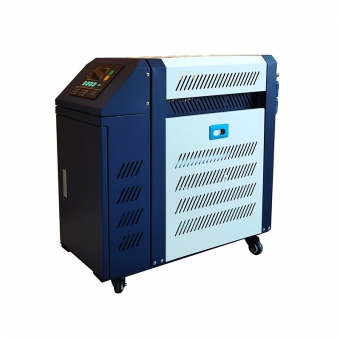
In injection molding workshops, the mold temperature machine is the key to improving the quality of plastic products. It ensures that the mold temperature is appropriate, allowing the plastic melt to uniformly fill the cavity and avoiding defects such as deformation and flow marks on the products. In the die casting industry, the mold temperature machine provides a stable high temperature for the mold, helping aluminum alloys, magnesium alloys and other castings to be accurately formed and improving surface finish. Whether it is rubber vulcanization or temperature maintenance of chemical reaction kettles, the mold temperature machine can play a significant role, meeting diverse industrial production needs.
As a core equipment in the field of industrial temperature control, the mold temperature machine integrates precise heating and efficient cooling functions. Through an intelligent temperature control system, it can stabilize the mold temperature at the set value with a temperature control accuracy of ±0.5℃ or even higher. This effectively ensures the constancy of mold temperature during production, significantly improves product quality and production efficiency, and is widely applicable to industries with strict temperature control requirements such as injection molding, die casting, and rubber.
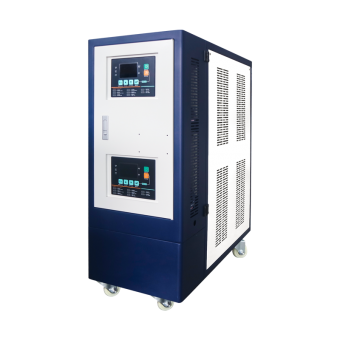
The dual-temperature integrated mold temperature controller is an advanced temperature control device specially designed for heating and cooling molds. It can simultaneously provide two different temperature control modes to meet the precise requirements of mold temperature in different process stages.
This oil-type mold temperature controller uses high-quality heat transfer oil as the heat transfer medium, with excellent temperature control capability, achieving a temperature control accuracy of ±0.5℃, which can provide a stable temperature environment for various production processes. It has high heating efficiency, can quickly raise the mold temperature to the set value, greatly shortening the production preparation time. In industries such as injection molding and die casting, it can effectively improve production efficiency and ensure stable product quality.

A plastic crusher machine is a device used to crush plastic into small pieces for easy disposal. The machine works by breaking down the plastic material into small pieces using a rotating blade. The crushed plastic can then be melted down and reused to make new products, thus reducing the amount of plastic waste in the environment. It is an essential machine in the plastic recycling process.

Plastic crushers specialize in breaking various plastic materials into plastic particles of different sizes. Crushed plastic can be recycled for use in the reproduction of plastic products, which is an important raw material for plastic recycling and pelletizing. It has the advantages of small space occupation, low power consumption, simple operation, and easy cleaning and maintenance. The particle size can be adjusted by replacing the screen.
Plastic crusher, also known as plastic grinder, is mainly used to crush various plastic and rubber materials, such as plastic profiles, pipes, rods, filaments, films and waste rubber products. It is widely used in waste - plastic recycling and the recycling of factory waste. The motor power of the plastic crusher is between 3.5 and 150 kilowatts, and the knife - roller speed is generally between 150 and 500 rpm.
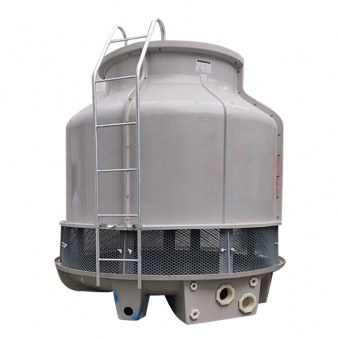
A cooling tower dissipates heat from industrial or air - conditioning systems. Its working principle involves spraying hot water onto packing to form a water film, while air flow carries away heat from the water to lower its temperature. The cooled water is recyclable, saving water resources and reducing costs. There are various types, such as open and closed cooling towers. Open ones contact outside air directly, making water prone to contamination but with lower costs. Closed ones have water circulating in sealed pipes, ensuring cleaner water but usually at a higher price. Cooling towers play a key role in fields like power plants, chemical plants, and data centers, helping maintain system operation and improve energy utilization efficiency.

The counterflow cooling tower is a common type of cooling tower. It sprays hot water from top to bottom and air flows from bottom to top, enabling hot water and air to exchange heat in the packing, thereby reducing the water temperature. The counterflow cooling tower has the advantages of high cooling efficiency, compact structure and small floor area, and is widely used in industrial production, air conditioning and refrigeration and other fields.

The vertical mixer machine is a space-saving industrial blending solution for diverse materials. Its high-torque motor and adjustable speed settings handle granular, powdery, or viscous pastes, ensuring uniform mixing. The sealed chamber prevents contamination and dust leakage, suitable for food, plastic processing, chemical, and building materials industries. Durable stainless steel construction ensures longevity, while user-friendly design simplifies operation, discharge, and maintenance. Ideal for small to medium production lines, it enhances product quality and efficiency across applications.

The plastic mixer is a kind of equipment used for mixing plastic particles, powders and other materials. Through a specific stirring method, it evenly mixes plastic materials of different types, colors or compositions to meet various needs in the plastic processing process. This equipment is widely used in fields such as plastic product production, plastic modification, and plastic recycling.
 :
:+8618520532504
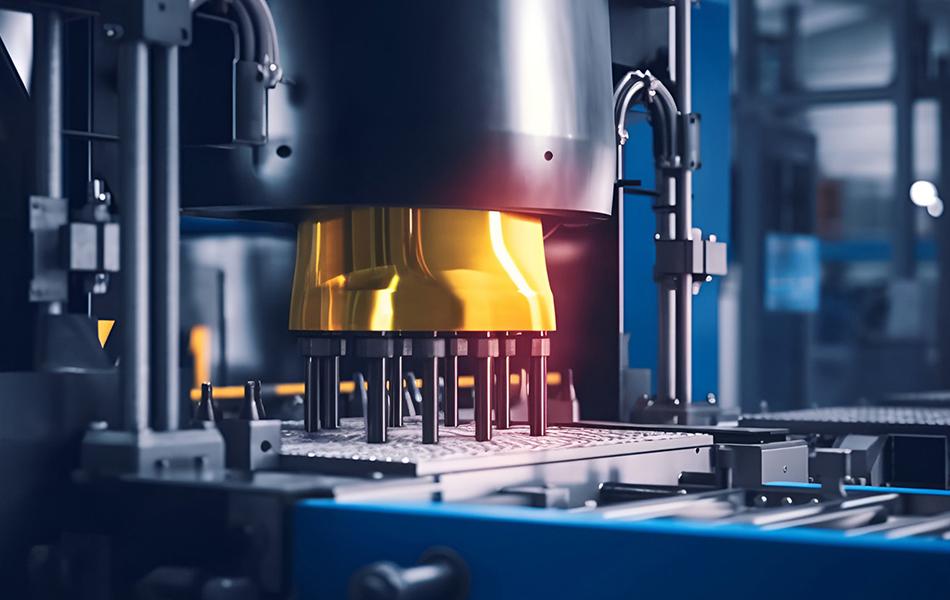
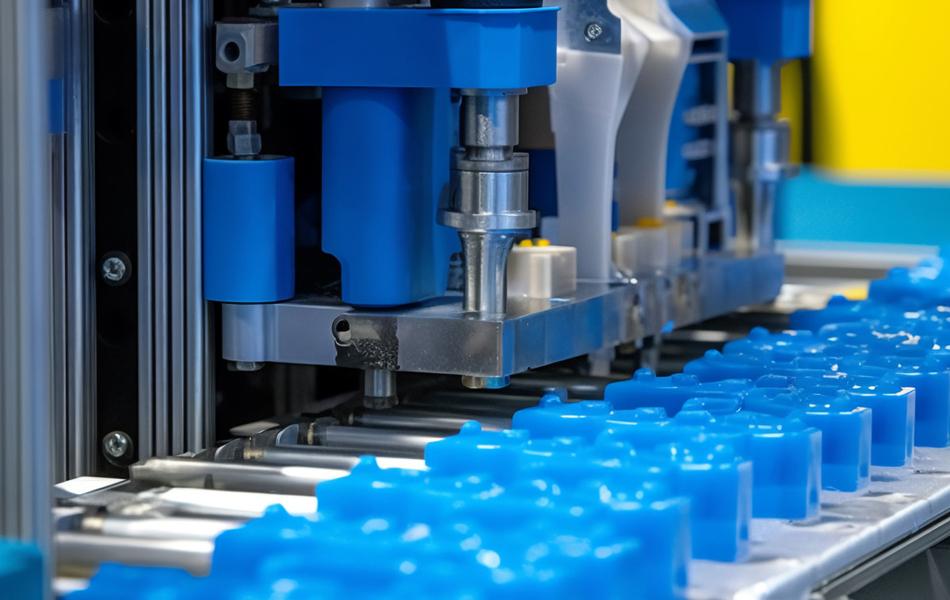









25 years of focus on innovation, R&D and production of industrial temperature control equipment.

We adopt advanced technology, use branded components, control every process of production, and each machine is shipped after passing professional testing.

The design team, composed of engineers with many years of experience in the temperature control industry, is committed to solving engineering problems for customers one-on-one, perfect matching, and providing reasonable and practical temperature control solutions.

Free technical service, solution design, installation guidance, nationwide warranty.

The plastic crusher is widely used in the plastic recycling industry. It can crush various waste plastic products, such as plastic bottles, plastic films, plastic pipes, etc., into small particles for reprocessing and utilization. This not only reduces the environmental pollution caused by waste plastics but also realizes the recycling of resources.

Cooling tower is a heat dissipation device. It sprays hot water on the packing and exchanges heat with air to reduce the water temperature. Widely used in industrial fields such as chemical industry and power generation, it provides guarantee for equipment cooling.
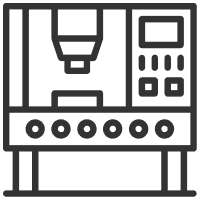
Mold temperature controller precisely controls the mold temperature to optimize the production process. There are water temperature and oil temperature types.

An industrial chiller is cooling equipment composed of compressor, condenser, expansion valve, and evaporator. It provides constant temperature, flow, and pressure. With large refrigeration capacity and high efficiency, it can offer cooling water in a temperature range of -5°C to 35°C.
A Compliant Choice for Food Production Cooling: 4 Core Advantages of 50 HP Air-Cooled Chillers In food production processes, temperature control is directly related to product safety, quality stability, and production compliance. Excessively high or fluctuating temperatures can easily lead to food spoilage, microbial growth, and may also affect the compliance of production processes. With targeted design and performance, 50 HP air-cooled chillers have become the preferred cooling equipment for food production workshops and warehouses. Their core advantages directly address industry pain points, building a solid temperature defense line for production links. Precise Temperature Control, Meeting Strict Food Production Standards Food processing, fresh-keeping and other links have extremely high requirements for temperature accuracy. Most scenarios need to maintain a constant range of 0-25℃. Equipped with a high-precision temperature control system, 50 HP air-cooled chillers can control temperature fluctuation within ±1℃, effectively avoiding product spoilage, poor taste and other problems caused by temperature imbalance. At the same time, the equipment supports on-demand adjustment of wind speed and cooling intensity, adapting to the cooling needs of different food production scenarios such as baking, refrigeration, and cooked food processing. Energy-Efficient and High-Performance, Reducing Production and Operation Costs Food production is often accompanied by 24/7 continuous operation, and the energy consumption of cooling equipment directly affects enterprise operating costs. 50 HP air-cooled chillers adopt high-efficiency compressors and optimized air duct design, with cooling efficiency 15%-20% higher than traditional equipment. They can save a lot of power consumption under the same cooling effect. Their intelligent start-stop function can also automatically adjust the operating state according to the workshop temperature, avoiding invalid energy consumption. Long-term use can significantly reduce production costs for enterprises and improve profit margins. ----------------------------- Safe and Compliant, Adapting to Hygiene Requirements of the Food Industry The food production industry has strict regulations on equipment hygiene and safety. 50 HP air-cooled chillers use food-grade environmentally friendly refrigerants, which are non-toxic, odorless, and non-polluting to food materials, complying with national food safety standards. The equipment body is made of corrosion-resistant and easy-to-clean 304 stainless steel, with a smooth surface without dead corners, which can effectively avoid bacterial growth and facilitate daily cleaning and disinfection. It meets the hygiene management requirements of food production workshops and helps enterprises pass compliance audits. Stable and Durable, Ensuring Uninterrupted Continuous Production The food production process is continuous, and the stability of cooling equipment directly affects pro...
read more+In manufacturing industries such as injection molding, die casting, and extrusion, mold temperature controllers, as core equipment for controlling mold temperature, typically account for 15%-30% of the total production energy consumption. With the continuous rise in energy costs, energy-saving transformation of mold temperature controllers has become an important breakthrough for enterprises to reduce costs and increase efficiency. This article will share 3 practical and verified energy-saving transformation schemes for mold temperature controllers, helping enterprises significantly reduce energy consumption while ensuring production quality. Scheme 1: Replace with High-Efficiency Heating Elements to Reduce Heat Loss Traditional mold temperature controllers mostly use ordinary metal heating tubes, with a heat conversion efficiency of only 70%-80%, and a large amount of heat is lost through the shell during the heating process. The first step in energy-saving transformation is to replace the heating elements with ceramic heating tubes or electromagnetic heating coils. The heat conversion efficiency of ceramic heating tubes can reach more than 90%, and they have the characteristics of fast heating speed and small thermal inertia; electromagnetic heating makes the metal barrel heat itself through electromagnetic induction, avoiding heat conduction loss, and the thermal efficiency can even reach 95%. At the same time, adding high-temperature resistant insulation cotton to insulate the heating chamber and pipelines of the mold temperature controller can further reduce heat loss. After replacing ceramic heating tubes and adding insulation transformation, an injection molding enterprise reduced the daily power consumption of a single mold temperature controller from 80 kWh to 55 kWh, saving 750 kWh of electricity per month, with a significant energy-saving effect. --------------占位--------------- Scheme 2: Install Waste Heat Recovery System for Secondary Utilization of Waste Heat During the cooling cycle of the mold temperature controller, a large amount of high-temperature waste heat is generated (such as high-temperature oil after cooling of oil temperature machines and hot water discharged by water temperature machines). If this waste heat is directly discharged, it not only wastes energy but also increases the cooling load of the workshop. Installing a waste heat recovery heat exchanger is an effective way to solve this problem. Specifically, a plate heat exchanger can be connected in series in the cooling circuit of the mold temperature controller to transfer the waste heat to the cold water in the cold water tank. The preheated cold water then enters the heating chamber of the mold temperature controller, reducing energy consumption during the heating stage; in addition, the recovered waste heat can also be used for workshop heating, preheating of employees' domestic water and other scenarios. After installing a waste heat reco...
read more+Many plastic recycling operations handle diverse material streams—from rigid thick plates and injection molding sprues to flexible films and thin sheets. While no single shredder is "one-size-fits-all," strategic configurations can transform an industrial plastic shredder into a multifunctional tool capable of processing multiple material types efficiently. The key lies in adjusting core components to match the physical properties of each material. For thick plastic plates (e.g., PC sheets, HDPE plates) and large rigid parts, the priority is high torque and durable blades. Configure the shredder with thick, carbide-tipped blades (hardness ≥HRC60) to withstand the impact of dense materials. Increase the knife shaft speed moderately (20-30 RPM) to ensure effective shearing, and select a larger feed opening (≥400mm×500mm) to accommodate bulky plates. Additionally, equip the machine with a reinforced hopper to prevent deformation under the weight of heavy materials. This setup allows the shredder to process thick plates up to 50mm without jamming or blade damage. ----------------------------- Flexible materials like PE films and PVC hoses pose a risk of wrapping around the knife shaft. To address this, install anti-winding blades with serrated edges, which grip and cut films without allowing them to tangle . Reduce the knife shaft speed (15-20 RPM) to minimize centrifugal force that pulls films around the shaft, and add a tensioning device in the feed hopper to flatten and feed films evenly. Some advanced models also feature a "film compactor" attachment that pre-presses films into dense bundles before shredding, further improving efficiency. Injection molding sprues and small plastic parts require precise particle size control for downstream recycling. For this, use a medium-hardness blade (HRC55-58) and a fine-mesh screen (3-5mm) to ensure uniform granules. Adjust the blade gap to 0.1-0.2mm for clean cuts, and equip the shredder with a vibration feeder to regulate the feed rate—this prevents overloading and ensures consistent particle output. Adding a dust collection system is also beneficial, as sprue processing can generate fine plastic dust that affects workshop air quality. ----------------------------- To maximize multifunctionality, choose a shredder with modular components that can be easily swapped. For example, a model with interchangeable blade sets, adjustable screen meshes, and optional feed attachments (like vibratory feeders or film compactors) allows quick reconfiguration between materials. Regular maintenance—such as blade sharpening every 200-300 hours and screen cleaning—also ensures consistent performance across different material types. By tailoring configurations to each material’s needs, an industrial plastic shredder can effectively handle thick plates, films, sprues, and more, reducing the need for multiple specialized machines.
read more+In plastic processing and recycling production lines, plastic shredders are core equipment for handling sprue materials and waste plastics. However, under long-term high-load operation, faults such as material jamming, excessive dust, and blade overheating occur frequently, which not only affect production efficiency but also may accelerate equipment wear. Mastering quick solutions to these faults can help enterprises reduce downtime and lower operation and maintenance costs. 1. Material Jamming: Identify Causes and Handle Precisely Material jamming is the most common fault of plastic shredders, mostly caused by improper feeding, inadequate equipment adaptability, or component aging. It needs to be solved in three steps: "inspection - handling - prevention": Emergency Handling: Stop Feeding First, Then Dismantle When material jamming is detected, immediately close the feed inlet and cut off the shredder's power supply (trigger the emergency stop button directly if available) to prevent motor burnout due to overload. After the equipment stops completely, open the machine cavity inspection door and clean the plastic residues stuck between the blades and the screen. If the residues are hard (such as solidified ABS sprue materials), use a dedicated crowbar to gently peel them off; do not strike the blades with brute force to avoid edge chipping. Root Cause Inspection: Confirm One by One from Feeding to Equipment Feeding Issues: If the feeding speed is too fast (e.g., pouring too much at once during manual feeding) or the size of plastic blocks exceeds the equipment's rated feed port diameter (e.g., putting 10cm×10cm PP waste parts into a shredder only suitable for materials under 5cm), material accumulation and jamming are likely to occur. Adjust the feeding rhythm or cut large plastic blocks into suitable sizes in advance. Equipment Adaptability: Improper selection of screen mesh aperture can also cause jamming. For example, using a 2mm fine screen to shred tough PE materials will easily block the screen holes with crushed particles, preventing subsequent materials from being discharged and causing jamming. Replace the screen with a corresponding aperture according to the plastic material and particle requirements (e.g., 5-8mm screen is recommended for PE materials, and 3-5mm screen can be used for ABS materials). Component Aging: Severe blade wear (dull edges, gaps) or loose drive belts will reduce shredding efficiency, causing materials to accumulate and jam as they cannot be crushed in time. Regularly check the sharpness of the blades (it is recommended to grind them every 200 hours; replace them if wear exceeds 1mm) and adjust the belt tension (the belt should sink 1-2cm when pressed). Preventive Measures: Establish Feeding Specifications Formulate a "layered feeding" system: classify and process plastics of different hardness and sizes, such as shredding soft PE films and hard PC blocks separately; for p...
read more+In high-load industrial scenarios such as chemical engineering, iron and steel production, and electronic manufacturing, the production process has extremely strict requirements for temperature control. Screw chillers are required to provide continuous and stable refrigeration capacity to ensure the smooth progress of production processes and product quality. Any interruption in refrigeration may lead to product scrapping, equipment damage, and even safety accidents. Therefore, how to ensure that screw chillers achieve continuous refrigeration under high-load working conditions has become a core concern for industrial enterprises. 1. Equipment Selection and Configuration Optimization (1) Matching Refrigeration Capacity Requirements In high-load industrial scenarios, refrigeration demand is large and fluctuates frequently. When selecting equipment, it is necessary to accurately calculate the refrigeration capacity. Based on factors such as the heat load of the production process and environmental heat dissipation, determine the rated refrigeration capacity of the screw chiller, and reserve a certain margin to cope with peak loads. For example, in the cooling of chemical reaction kettles, a large amount of heat is released during the reaction process, and there is a significant difference in heat load between the initial stage and the stable stage of the reaction. Therefore, it is necessary to select a screw chiller with a wide refrigeration capacity range and flexible adjustment capabilities. At the same time, consider the parallel operation scheme of multiple units: some units can be shut down during low-load periods, and all units can be put into operation during peak-load periods. This not only meets the refrigeration demand but also avoids long-term high-load operation of a single unit, thereby extending the service life of the equipment. (2) Selecting High-Efficiency Compressors The compressor is the core component of a screw chiller, and its performance directly determines the refrigeration capacity and stability of the chiller. Under high-load working conditions, priority should be given to compressors with high compression ratio, large displacement, and high efficiency. For instance, compressors with an asymmetric double-screw rotor design, combined with nanoscale surface coating technology, can reduce internal leakage and friction losses, increasing compression efficiency by 12-18%. Moreover, they can withstand higher pressure and adapt to high-load operation. Some high-end compressors also have an adaptive adjustment function: when the ambient temperature or load changes, they automatically adjust the compression ratio to maintain stable output of refrigeration capacity. (3) Strengthening the Heat Exchange System An efficient heat exchange system is crucial for ensuring continuous refrigeration. The condenser and evaporator should adopt high-efficiency heat transfer materials and advanced structural designs to improve heat exchange effic...
read more+Both air cooled chillers and water cooled chillers are core industrial cooling systems, relying on the vapor compression cycle (as detailed in the earlier industrial chiller working principle guide) to remove heat. However, they differ significantly in heat dissipation methods, structure, performance, and application scenarios—critical factors for buyers to choose the right model. Below is a detailed comparison of their key differences. 1. Core Difference: Heat Dissipation Method (Condenser Operation) The fundamental distinction lies in how the condenser (a key component in the refrigeration cycle) releases heat to the external environment—this directly shapes the chiller’s design and usage conditions. Air Cooled Chiller Heat Dissipation Medium: Uses ambient air as the cooling medium. Condenser Design: Equipped with an air-cooled condenser (finned coils + fans). After the compressor outputs high-temperature refrigerant vapor, the vapor flows through the condenser coils; fans blow ambient air over the fins, transferring heat from the refrigerant to the air, which is then discharged to the atmosphere. No Additional Water System: Does not require a separate water supply or circulation system for cooling, simplifying installation. Water Cooled Chiller Heat Dissipation Medium: Uses water (usually from a cooling tower or tap water) as the cooling medium. Condenser Design: Features a water-cooled condenser (shell-and-tube or plate heat exchanger). High-temperature refrigerant vapor enters the condenser, and cooling water flows through the exchanger’s tubes; heat is transferred from the refrigerant to the water, which then carries the heat away (e.g., to a cooling tower, where the water is cooled and recycled). Depends on Auxiliary Water Systems: Requires matching equipment like cooling towers, water pumps, and pipelines to circulate and cool the water—adding complexity to the overall system. 2. Structural & Installation Differences Air Cooled Chiller Structure: More compact, integrating the condenser, fans, and main unit into one system. No need for additional water tanks, pumps, or cooling towers. Installation Requirements: Needs sufficient open space (e.g., rooftops, outdoor yards) to ensure unobstructed air flow—blocked air intake will reduce heat dissipation efficiency. Requires minimal pipeline work (only for process fluid circulation, not cooling water). Shorter installation time (typically 1-2 weeks for small-to-medium models). Water Cooled Chiller Structure: The main unit (compressor, evaporator, condenser) is separate from auxiliary equipment (cooling tower, water pump, water treatment system), leading to a more scattered layout. Installation Requirements: Needs space for both the chiller unit and auxiliary water systems (cooling towers are often installed on rooftops, while pumps may be in machine rooms). Requires complex pipeline installation (for cooling water circulation, includ...
read more+In modern industrial production and commercial applications, chillers, as key refrigeration equipment, are widely used in numerous industries such as pharmaceuticals, chemicals, electronics, food, and air conditioning systems. Air-cooled chillers and water-cooled chillers, as the two mainstream types in the chiller family, each play an important role in different application scenarios with their unique advantages and characteristics. Next, let's have an in-depth understanding of these two types of chillers. Air-cooled Chillers: Convenient and Flexible Refrigeration Pioneers Air-cooled chillers cool room-temperature water via a compressor to enhance cooling for molds or machines, comprising three key systems: refrigerant circulation (liquid refrigerant evaporates in the evaporator, is compressed, condenses in the condenser, and throttles back), water circulation (pump delivers water to equipment, which returns after absorbing heat), and electrical control (powers components and automates operation/protection). They feature easy installation (no cooling tower needed, compact and movable, ideal for water-scarce areas), stable performance (quality components, safety devices, low noise, long life, user-friendly interface), energy efficiency (some with multi-compressor systems adapting to loads), and strong adaptability (suitable for cooling various equipment like CNC machines and laser tools). However, they have lower COP (2.6-3.3), require good ventilation, and their cooling capacity drops in high-temperature workshops. Water-cooled Chillers: Efficient and Stable Refrigeration Mainstays Water-cooled industrial chillers, or water-cooled box-type units, use water as a heat exchange medium with a cooling tower. Their refrigerant circulation is similar to air-cooled ones, with cooling water dissipating heat via the tower. Structurally, they include a chilled water tank, pump, unit, cooling tower, and pipes, usable after connecting pipes and 380V power. They offer efficient refrigeration (higher energy efficiency by 300-500kcal/h than air-cooled due to water's properties), precise temperature control (5°C-35°C, suited for processes like plastic molding), stable operation (efficient heat exchangers, safety systems), and wide application (medical, food, chemical, etc.). But they need auxiliary equipment (larger footprint, complex installation), require good water quality to prevent scaling/blockages, and demand regular maintenance. In conclusion, air-cooled chillers and water-cooled chillers have their own advantages and disadvantages. In practical applications, users should comprehensively consider their specific needs, installation environment, operating costs and other factors to choose the most suitable type of chiller, so as to achieve efficient, stable and economical refrigeration effects. With the continuous progress and innovation of refrigeration technology, air-cooled chillers and water-cooled chillers will...
read more+Industrial water chillers play a core role in air conditioning systems by providing a stable supply of low-temperature chilled water, supporting cooling for buildings or specific spaces. Here’s how they are applied and their underlying principles: I. Core Role in Air Conditioning Systems Industrial water chillers (such as scroll or screw types) generate low-temperature chilled water (typically 7–12°C) through a refrigeration cycle. This chilled water is pumped to terminal air conditioning equipment (e.g., fan coils, air handling units), where it exchanges heat with indoor air, absorbing heat to lower room temperatures and achieve cooling. ----------------------------- II. Integration with Air Conditioning Systems The integration of industrial water chillers with air conditioning systems is typically achieved through a "water system," following this process: Chilled Water Production: In the chiller’s evaporator, refrigerant absorbs heat from the water, lowering its temperature to a set value (e.g., 7°C). Chilled Water Circulation: The low-temperature water is pumped to terminal air conditioning equipment (fan coils, air handling units, etc.). Terminal Heat Exchange: At the terminals, chilled water absorbs heat from warm indoor air, cooling the air while the water itself warms to around 12°C. Return Water Recooling: The warmed water flows back to the chiller’s evaporator, where it is recooled by the refrigerant, completing the cycle. ----------------------------- III. Suitable Scenarios for Air Conditioning Industrial water chillers, valued for their high cooling capacity and stability, are ideal for medium-to-large air conditioning systems, including: Commercial Buildings: Office towers, shopping malls, hotels, etc., requiring centralized cooling for large spaces. Public Facilities: Hospitals, stadiums, airports, where reliable air conditioning operation is critical. Industrial Plants: Workshops needing both process cooling and employee comfort (e.g., electronics or precision instrument workshops). Large Data Centers: Maintaining a constant ambient temperature (typically 20–25°C) for equipment and staff, with chillers serving both cooling needs. IV. Advantages Over Traditional Air Conditioners High Cooling Capacity for Large Areas: A single industrial chiller can deliver tens to hundreds of refrigeration tons, covering spaces over 10,000 square meters without needing multiple small units. Higher Energy Efficiency, Lower Operating Costs: Equipped with high-efficiency compressors (scroll, screw) and heat exchangers, combined with inverter control, they achieve a higher COP (Coefficient of Performance) at partial loads than conventional air conditioners. Centralized Control for Easy Management: A central control system regulates cooling output, water temperature, and pump operation, adjusting dynamically to indoor loads to reduce energy waste. Flexible Installation fo...
read more+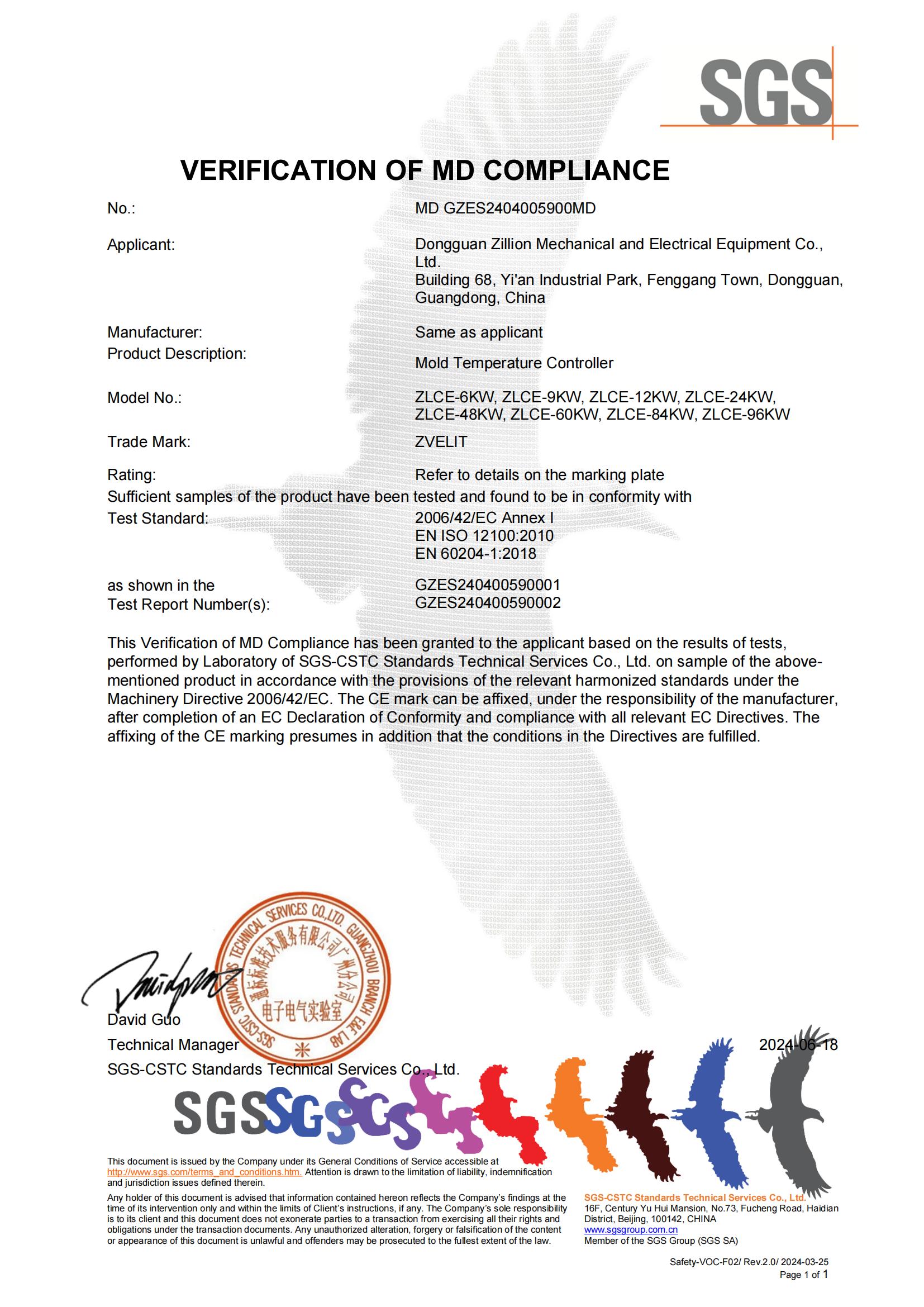
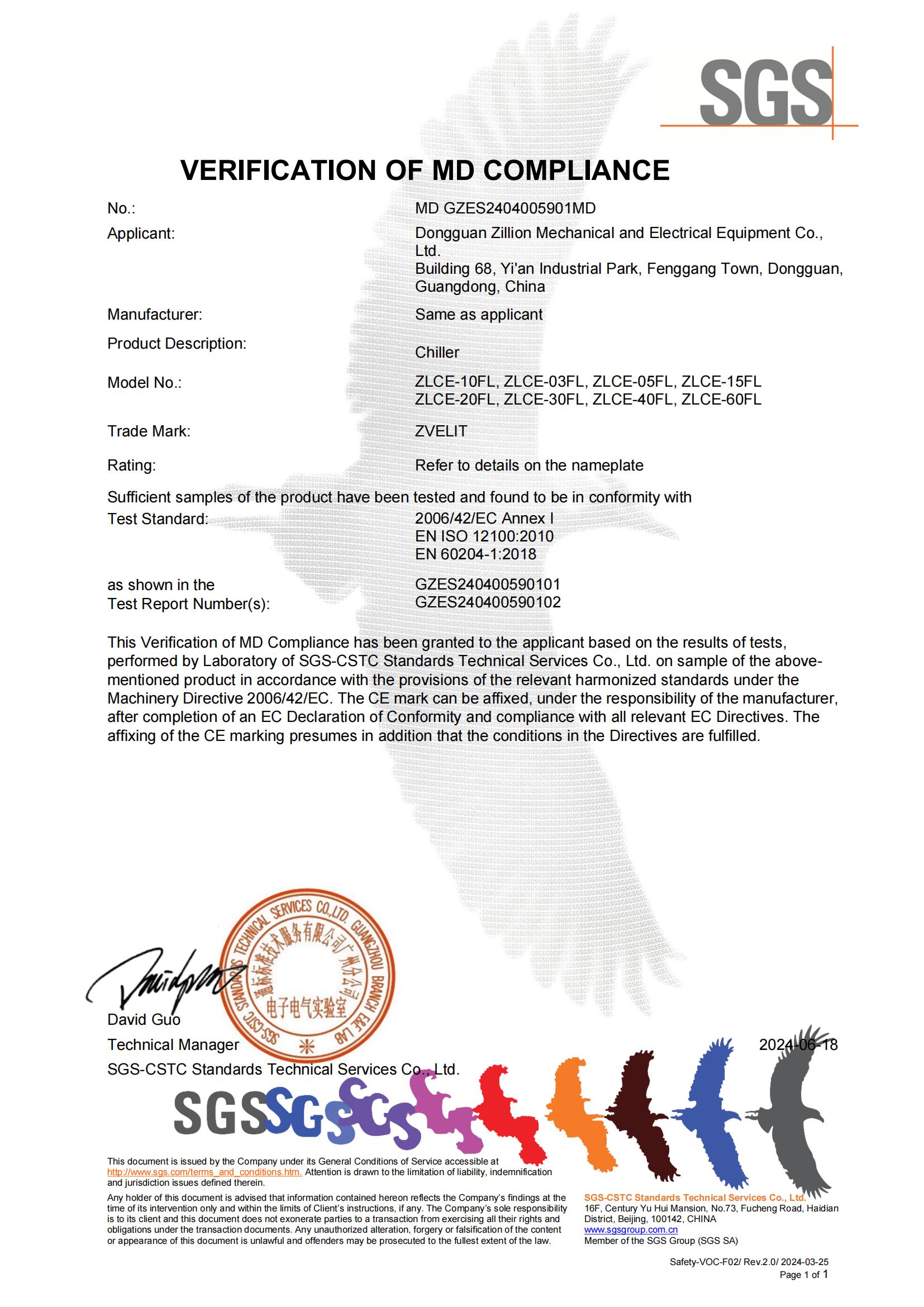


Our company's series of products are well-known in the plastic auxiliary machinery industry for their excellent performance and high cost performance.
 IPv6 network supported
IPv6 network supported



